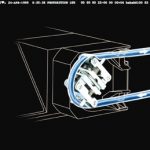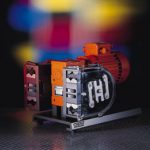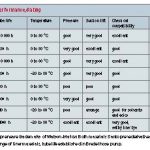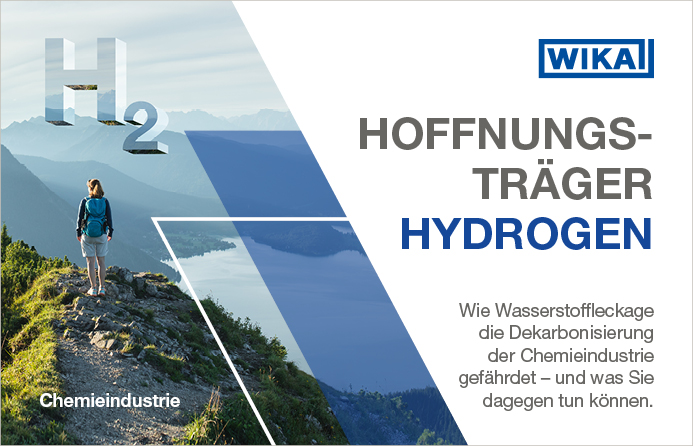Tube pumps requiring minimal maintenance have long since proved their worth as a low-cost alternative in the chemical industry. Their functional principle makes them especially suitable for pumping highly corrosive or aggressive fluids. The directly coupled, peristaltic pump with two 601R heads is capable of metering several different fluids simultaneously.
The principle of peristaltic pump opera-tion is sufficiently well-known to need no further explanation here (Fig. 1). The choice of tube material and design has a crucial influence on the pump’s performance. The restoring force of the tube deter-mines its suction characteristics, while its pressure-loading capability is dependent on its thickness. High-pressure tube pumps, which use reinforced tubes, thus pump continuously against a pressure of 16 bar, while low-pressure pumps without any tube re-inforcement pump against a pressure of around 2 bar. The maximum flow rate achieved by peristaltic pumps is approximately 80 m³ per hour.
Key benefits of peristaltic pumps
The pumped fluid remains inside the tube, and is thus completely separate from the mechanical parts of the pump. This is particularly useful if the fluid is corrosive, aggressive or abrasive, which is the case with many process chemicals. It is also helpful if the process fluid or colour changes: there is no need to strip the pump or to clean it using potentially harmful solvents or cleaning agents – simply change the tube and the pump is ready to handle a different chemical or colour without any risk of cross-contamination. The peristaltic pumping action exerts a very low shear force on the pumped fluid, which ensures that shear-sensitive fluids (paint pigments and polyelectrolytes, for example) can be pumped without degradation. The low shear action is the result of two factors: firstly, the peristaltic pump is based on the positive displacement principle, which means that there is no slip-induced shear and secondly, the maximum rate of shear is determined by the maximum velocity of the fluid in the tube, rather than by the relative velocity of a high-speed rotor to a fixed stator or by the high velocities that result from valve constriction.
When the roller occludes the tube, the fluid flows away from the occlusion point and any solids directly at this point will tend to move away as well. Any particles that remain temporarily embed themselves in the wall of the elastomer tube, and are moved forward with the next pocket of fluid. A peristaltic pump will typically pump solids up to 25% of the tube bore and can therefore handle crystallising chemicals, industrial wastes and similar products without damage.
A peristaltic pump can operate in either direction without any problems. The only change in pumping characteristics occurs in pumps with sprung rollers, where the change from roller ‚leading‘ to ‚following‘ alters the effective spring rate and therefore also the suction and pressure characteristics.
Peristaltic pumps can achieve metering repeatability with a variation of less than 0.5% – thanks to a combination of the pump head design, the tube performance and the speed control circuitry. The flow rate from a peristaltic pump is determined by the rotor speed and the bore of the tube. As pumps will commonly accept different sizes of tube, the range of flow rates that one pump can generate is very wide. The 505Du/RL pump, for example, has a speed control ratio of 220:1. Coupled with a tube bore range of 0.5 to 8 mm, the flow rate range is 0.04 ml/min to 2.2 l/min.
Lifespan and tube material
There are eight different types of tube material for peristaltic pumps, as shown in Table 1. The most common tube materials in indus-trial applications are Marprene, a thermoplastic elastomer which offers an excellent lifespan and chemical compatibility, and Neoprene, a synthetic rubber with a high abra-sion resistance. The tube lifespans shown here are average maximum values, established by experimentally pumping water at zero pressure and suction in a 501RL pump head. The actual tube life depends on the application conditions and the pump head. It will be shorter if the pressure, suction lift and temperature are higher as well as in the event of chemical attack.
Examples of peristaltic pumps in operation
Accurate and repeatable metering of process fluids into dispersion mills is critical for achieving uniformity from one batch of paint pigments to another. In view of their ability to provide consistent, reproducible flows at low volumes, peristaltic pumps were chosen to replace double-diaphragm pumps at BASF’s Michigan paint mixing plant. The pumps require minimal set-up times and maintenance. The seal-less design eliminates the need to clean the pumps, thereby avoiding the costs, health hazards and environmental consequences associated with cleaning solvents.
Easy cleaning, high flow rates and precise metering are the key reasons why Eastman Kodak uses peristaltic pumps at its Rochester, New York, plant. Photographic chemicals are dissolved in a solvent, and the solution then dispensed into bottles in extremely precise amounts under computerised control. The only form of maintenance required by the pump consists of periodic flushing of the tubing or, in some cases, simply re-placing tubing in which polymer build-up has produced a blockage. Quick, straightforward cleaning is important, since the solu-tions are constantly changing and the tubing must be cleaned before each change.
Peristaltic pumps replace pressure regulators
Peristaltic pumps have replaced pressure regulators in a key stage of the coating process of a high-capacity storage tank manufacturer, as these pumps offer better flow control and improved material utilisation.
The company manufactures a wide range of storage tanks that are formed from glass-coated, sheet-steel plates. The tanks are used to store solid and liquid products in a variety of agricultural, industrial and effluent applications. The panels that make up the tanks have a corrosion-resistant glass coating fused onto both sides. The tanks are prefabricated for on-site assembly and are avail-able in a number of high-performance grades and a variety of colours.
As part of the panel coating process, the company sprays a precisely controlled coating formulation onto the surface of the prepared steel sheet. The pumped formulation is a suspension of minerals, clay and catalytic agents which is both highly abrasive and toxic. The pressure regulator equipment previously used for this purpose was unable to cope adequately, either with differences in the fluid viscosity or with the variations in the back pressure generated by the spray guns as they moved vertically to cover the sheet surface. The 505U/RL pumps were selected to replace them because they offered constant delivery, precise adjustment and minimal maintenance. Installed in-line with the existing control system, the 505U/RL pumps now deliver a precise volume of material to the spraying system.
The pumps‘ remote stop/start facility, permitting instant control, has been integrated with the spray gun controls to allow accu-rate targeting of the spray as well as product economy. They can also be remotely controlled by an analogue V or mA signal. The 505U/RL pumps are fitted with Marprene tubing and normally operate for around 14 hours per day in a dusty environment subjected to frequent washing down.
Directly coupled peristaltic pumps
The Duplex pumps have been designed specifically for applications where two or more chemicals need to be metered into a process or a reactor vessel (Figure 2). The pumps feature a robust, IP55, industrial geared motor coupled to a rugged pump head, and present a very cost-effective pumping solu-tion with all the benefits of peristaltic pumps. As the pump heads are driven by a shared drive, the ratio of the delivered chemicals will always remain constant. As different tube sizes can be used in each pump head however, the delivered volume need not necessarily be the same. Two models are available, offering flow rates from 2.2 ml/min to 16 l/min per channel in the fixed-speed versions. The Trio pumps are of a similar design, but offer speed control through an integral, IP55 frequency inverter. The speed control ratio is 10:1 and the flow rate range is 0.5 ml/min to 16 l/min. They are ideally suited to process applications where operation (speed as well as stop/start) is automatically controlled. They are available in either single pump head or duplex versions.
Watson Marlow
Fax: ++49/2183/82592
Further information cpp-244
Unsere Whitepaper-Empfehlung
Wasserstoff gilt als Schlüssel für die Dekarbonisierung der Chemieindustrie. Doch die Nutzung des vermeintlichen Hoffnungsträgers Hydrogen birgt auch Gefahren und stellt die Branche vor neue Herausforderungen, die das gratis Whitepaper „H2 wie Hoffnungsträger?“ näher für Sie…
Teilen:














